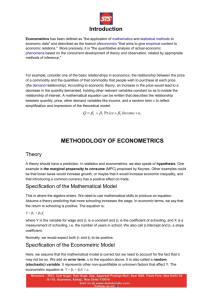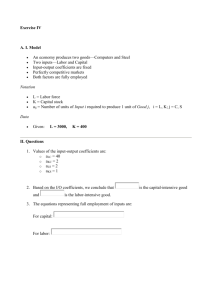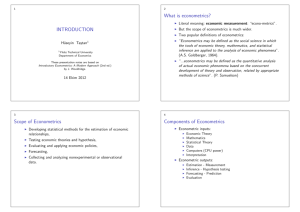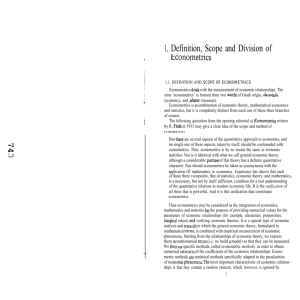What is econometrics for?
advertisement
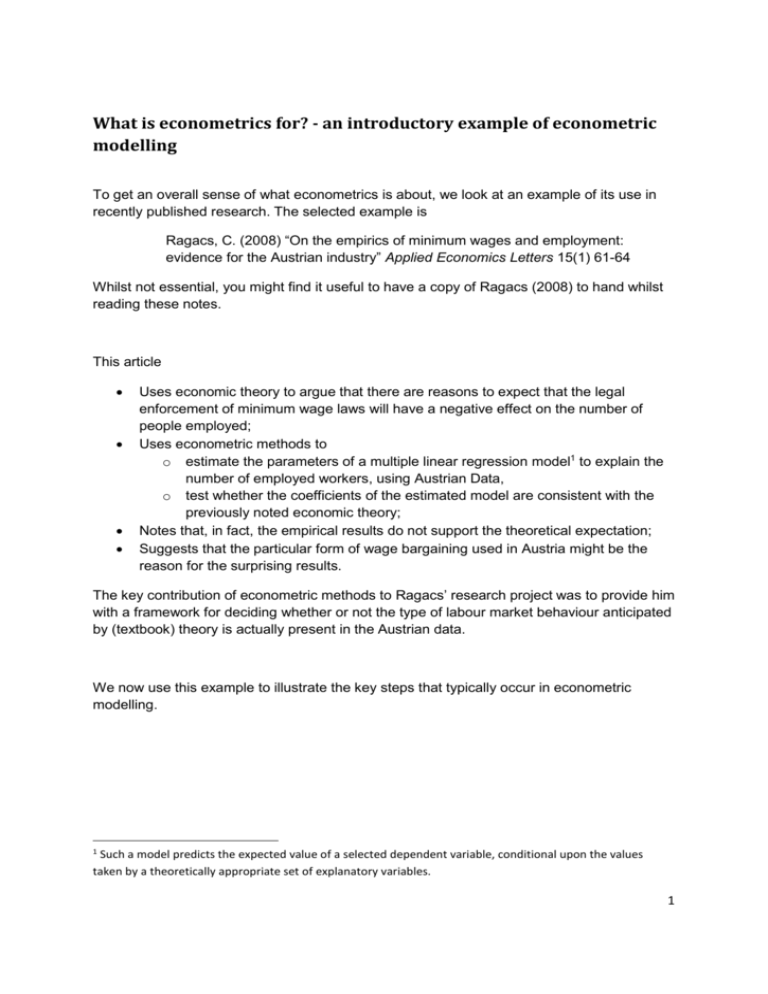
What is econometrics for? - an introductory example of econometric modelling To get an overall sense of what econometrics is about, we look at an example of its use in recently published research. The selected example is Ragacs, C. (2008) “On the empirics of minimum wages and employment: evidence for the Austrian industry” Applied Economics Letters 15(1) 61-64 Whilst not essential, you might find it useful to have a copy of Ragacs (2008) to hand whilst reading these notes. This article Uses economic theory to argue that there are reasons to expect that the legal enforcement of minimum wage laws will have a negative effect on the number of people employed; Uses econometric methods to o estimate the parameters of a multiple linear regression model1 to explain the number of employed workers, using Austrian Data, o test whether the coefficients of the estimated model are consistent with the previously noted economic theory; Notes that, in fact, the empirical results do not support the theoretical expectation; Suggests that the particular form of wage bargaining used in Austria might be the reason for the surprising results. The key contribution of econometric methods to Ragacs’ research project was to provide him with a framework for deciding whether or not the type of labour market behaviour anticipated by (textbook) theory is actually present in the Austrian data. We now use this example to illustrate the key steps that typically occur in econometric modelling. 1 Such a model predicts the expected value of a selected dependent variable, conditional upon the values taken by a theoretically appropriate set of explanatory variables. 1 Steps in building and using an econometric model Of course, not all applied econometric exercises follow exactly the same procedure. On the other hand, what we can see in Ragacs (2008) is fairly typical and might even serve as a model for your own application of econometric methods. STEP 1: Decide what is the “Dependent Variable”, i.e. the variable whose observed values are to be explained: the author chooses: ln Lt The logarithm of the number of workers employed in year t NOTE: variables are often measured in logarithms for econometric modelling NOTE: the subscript is used to emphasise that the model will seek to explain the values of the dependent variable that have been observed at particular dates. STEP 2: Decide, on the basis of economic theory, what are the appropriate potential explanatory variables for the given dependent variable. The author uses the theory of profit maximisation to arrive at the following list of explanatory variables. Definitely in the model: 0 An intercept term (The notation will be explained later) t A time trend to reflect the impact of technological progress; ln Yt The logarithm of an index of total output for each year; ln mt The logarithm of the minimum legal wage each year; t An unobservable error term, representing the existence of other unknown causal factors whose random fluctuations from year to year cause the dependent variable to not do exactly what is expected on the basis of the known explanatory variables alone. 2 Possibly in the model: ln Lt 1 The author admits the possibility that the current value of the dependent variable will be influenced by its own lagged value – because employers cannot immediately adjust the number of workers employed. (This is called the “Partial Adjustment” hypothesis and occurs in many applications.) The author has no a priori theoretical judgement as to whether the partial adjustment hypothesis is relevant so estimates different versions of the model, with and without this variable, so that a preferred model can be selected on the basis of econometric tests (“diagnostic statistics”). NOTE: We shall look at the version of the model which excludes ln Lt 1 from the set of explanatory variables. STEP 3: Note the anticipated signs of the model coefficients The model is ln Lt 0 1t 2 ln Yt 3 ln mt t The model’s coefficients are 0 , 1 , 2 , 3 . Their precise values are (usually) not specified a priori by theoretical arguments. It is normally the business of econometric methods to use data on the observed variables: ln Lt , t , ln Yt , ln mt , as a basis for estimating the values of the coefficients. A priori theoretical arguments might, however, allow us to specify the anticipated signs of some coefficients, for example: 1 0 2 0 3 0 Technological progress is theoretically expected to reduce the demand for labour. Increased economic activity is theoretically expected to increase the demand for labour. A higher minimum wage level is theoretically expected to reduce the demand for labour. STEP 4: Decide the data sample In the example we are looking at, the author uses annual data, from t 1984 to t 1995 , giving 11 observation points. This is in fact a smaller than desirable number of observations for estimating a multiple linear regression model (and hence a potential basis for not being convinced by his results). The author also had access to data for 1967 to 1983 but considered that the labour market institutions were very different in these two periods, so that the their data could not be used together. 3 STEP 5: Estimate the model Using the Ordinary Least Squares (OLS) method2, the author obtains: ln Lˆt 2.61 0.06t 0.83ln Yt 1.65 ln mt NOTE: L̂t is a common notation in econometrics for “the predicted value of Lt .” STEP 6: Assess the diagnostic statistics The estimated model shown above is actually presented in Ragacs (2008) as one line in a table of results from the several different models that the author experimented with. That row contains the following information. sample 84 - 95 constant 2.61 0.09 trend -.06 0.00 Y 0.83 0.00 m 1.65 0.00 DW 2.63 Adj.Rsq 0.98 The Adjusted R-squared statistic (“Adj.Rsq”) assesses the extent to which the model fits the observed values of the dependent variable. The maximum possible value for this statistic is 1.00 so the 0.98 in this example suggests that the model performs well in fitting the data (but note that it is only attempting to fit 11 data points.) The Durbin-Watson statistic (“DW”) assesses whether a problem known as “autocorrelation in the disturbances” is present. The observed value of 2.63 suggests that this is probably not a problem. The second row of numbers are “t-stat prob. values”. These can be (roughly) interpreted as reporting the estimated probability that the true coefficient value attaching to each explanatory variable is actually zero. [Remember: econometrics can only estimate the coefficients, not say exactly what their true values are.] It is common to use 5% probability, i.e. 0.05, as a critical value. Where a prob. value is larger than this then the possibility that the true coefficient value is actually zero should be taken seriously. Variables whose coefficient has a prob. value below 5% are typically described as “significant”. In this example all explanatory variables are significant, only the intercept coefficient has a prob. value large than 5%. 2 The OLS method for estimating the coefficients of a model calculates the values for the coefficients that make the predicted values of the dependent variable (across the whole data sample) as close as possible to the values that it was actually observed to take. 4 STEP 7: Interpret the results The diagnostic statistics do not reveal any major reason for not trusting the model’s results. The estimated coefficients for the time trend and for the level of output have their theoretically anticipated signs, also suggesting that the model performs well. The coefficient on the minimum wage does not have the sign predicted by “textbook theory” but this is precisely the theoretical detail that the author set out to examine empirically. The question addressed by this example of applied econometrics was “Do minimum wage laws reduce employment levels?”. The author found that, in the case of Austrian data, the answer seems to be “No” - higher minimum wage levels seem, in fact, to have a significantly positive effect on employment. © Vince Daly & Kingston University, October 6, 2009 This work is licenced under a Creative Commons Licence. 5



